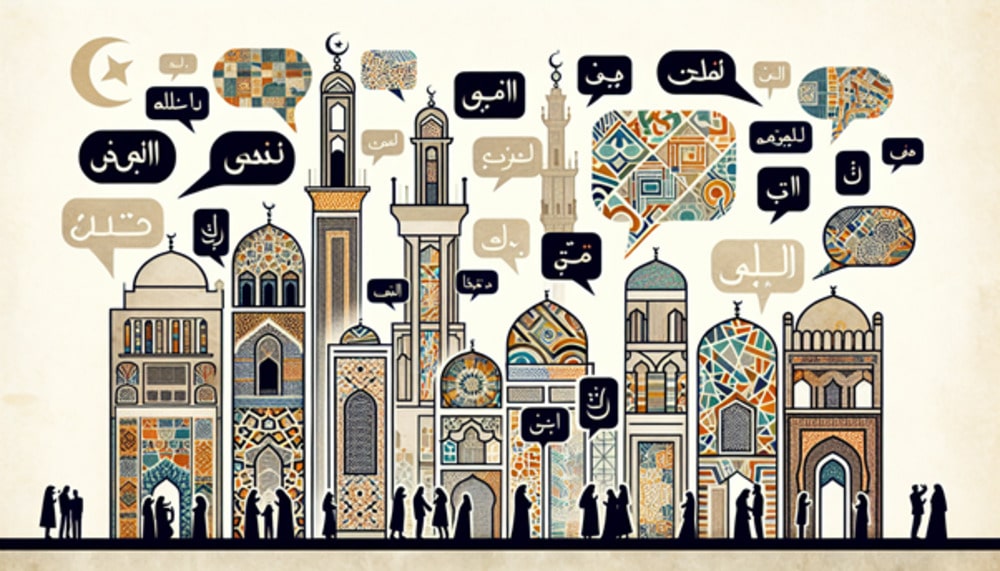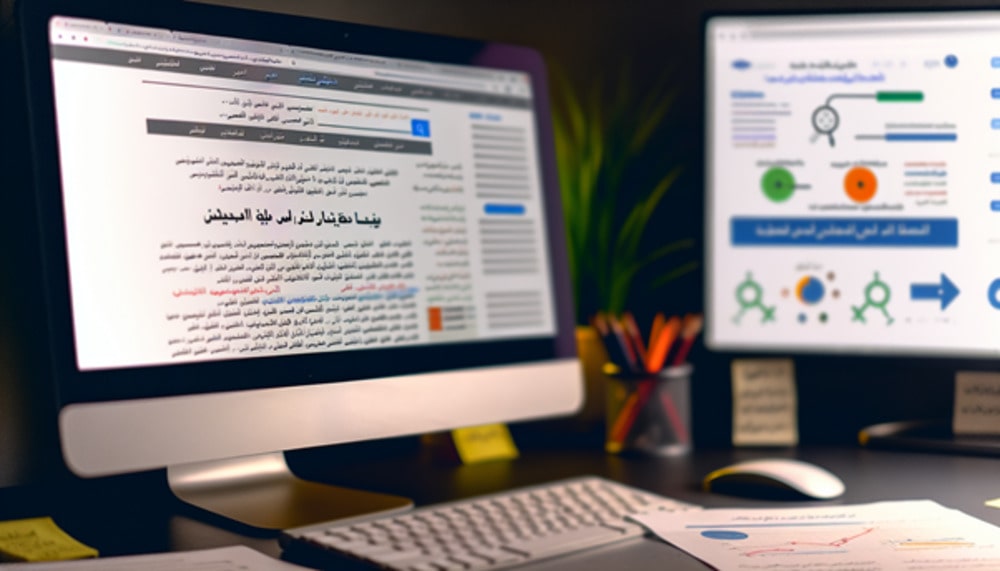Top-Rated Arabic Translation Services for Accurate and Quick Results

In an increasingly globalized world, the art of translation serves as a bridge, connecting cultures, ideas, and businesses. When it comes to the Arabic language, with over 500 million speakers worldwide, this bridge is not just a convenience – it’s a necessity. For businesses aiming to tap into the vast and diverse Arabic-speaking market, professional Arabic translation services are indispensable.
Key Takeaways
- Professional Arabic translation services provide comprehensive solutions for all communication and business needs.
- Experienced translators use advanced language technology to ensure high quality translations between English and Arabic, taking into account dialectic differences.
- Leveraging machine translation software combined with human expertise can produce accurate translations of top notch quality while keeping costs low.
Navigating the World of Professional Arabic Translation Services
Professional Arabic translation services are instrumental in connecting with the vast Arabic-speaking audience worldwide. They serve as the key to effective communication and business expansion in the 26 countries where Arabic is the official language. These services:
- Mitigate the risk of misinterpretation
- Ensure that the message is culturally appropriate
- Play a significant role in global businesses’ growth strategies.
Leading Arabic translation providers, such as a top-notch arabic translation company, utilize a well-organized process that includes online quotes, timely turnarounds, and teamwork with skilled translators. They utilize advanced technology to deliver swift, cost-efficient, and high quality arabic translation. Their focus on expertise tailored to specific industries allows them to manage complex arabic translation project while maintaining linguistic proficiency and accurate Arabic translations through their high-quality translation services. In addition, they are well-versed in popular arabic translation phrases, ensuring a seamless communication experience for their clients.
These agencies provide both Arabic and English translation services, positioning themselves as a comprehensive solution for all translation needs.
The Role of Professional Translators
Professional Arabic translators undergo rigorous testing to assess their translation skills and quality. With years of translation experience and relevant academic and professional qualifications, they ensure high-quality outcomes for every project. Not stopping at that, these translators also undergo continuous evaluation after each project, thereby maintaining high-quality results at all times.
The impact of technology in guaranteeing consistent and precise Arabic translations is undeniable. Advanced language technology solutions, such as artificial intelligence and machine learning, are integrated into the translation process, effectively combining machine and human capabilities. This combination of human skill and machine accuracy results in top-notch, uniform translations.
English to Arabic, Arabic to English
Translating between English and Arabic is not just about replacing words. It requires an in-depth understanding of both languages and their unique nuances. The task involves grappling with:
- the right-to-left script of Arabic
- the omission of short vowels in writing
- the distinctive feature of Arabic having verbal as well as nominal sentences.
Cultural and dialectic differences in Arabic further compound the complexity of the translation process. The diversity in official and casual communication and variations among regional dialects necessitate careful selection of the appropriate formality and dialect, ensuring that the translated content resonates with the intended audience.
Arabic Language Facts
With an estimated 422 million individuals speaking Arabic as their primary language and an additional 280 million using it as a secondary language, the global influence of the Arabic language is undeniable. Even the English language has integrated between 2,000 to 3,000 Arabic loanwords, demonstrating the Arabic language’s substantial influence.
Arabic is the official language in several countries, including:
- Lebanon
- Jordan
- Palestine
- Iraq
- Kuwait
- Saudi Arabia
- Bahrain
- Qatar
- Oman
- the UAE
- Yemen
The rich historical legacy of the Arabic language, dating back over 1,000 years, adds to its global significance.
Tailored Arabic Translation Services for Every Industry
Arabic translation services, including the specialized arabic translation service, cater to a diverse range of industries, offering services for:
- Islamic sciences
- Digital content
- Official documents
- Business transactions
- Legal documents
- Medical papers
Each industry has its unique set of requirements and challenges when it comes to translation, necessitating tailored services that can cater to these specific needs.
A prime example of this is the life sciences industry, which heavily relies on Arabic translation services for the localization of mission-critical content. The industry often relies on top translation companies to manage their intricate translation requirements, underscoring the significance of industry-specific expertise in translation.
Whether it’s translating a complex medical paper or a business contract, the importance of precision, cultural sensitivity, and industry-specific expertise cannot be overstated. This level of specialization ensures that the translated content not only conveys the intended message accurately but also resonates with the target audience, thereby increasing its effectiveness.
Technical Documents Translation
Precision is paramount in the translation of technical documents like data sheets, technical proposals, and manuals. The unique terminologies and concepts in these documents require specialized understanding, which professional Arabic translators with industry-specific expertise can provide.
Moreover, the translation should adhere to design specifications to ensure the utility and safety of the final product.
Business Document Expertise
Business documents encompass a wide range of materials such as:
- Product manuals
- Marketing collaterals
- Training courses
- Financial statements
- Legal materials
- Compliance documents
- Human resources information
- Merger and acquisition contracts
- Business emails
Each of these materials requires a specific set of skills and knowledge for accurate translation.
Professional Arabic translation services address this need by employing translators with extensive industry knowledge. These translators are proficient in comprehending and precisely translating technical jargon, thereby guaranteeing the preservation of the original meaning in the Arabic translation. This specialized expertise is crucial in overcoming the challenges posed by cultural nuances, managing dialect variations, and understanding complex sentence structures.
Medical and Legal Accuracy
In industries like medicine and law, accuracy is paramount. Any mistakes in translation can have serious implications. Therefore, Arabic medical translators need specialized knowledge as medical professionals in various medical disciplines, along with a deep understanding of medical terminology and concepts in English and Arabic. They are required to:
- Ensure accuracy
- Maintain confidentiality
- Be culturally sensitive
- Comply with relevant regulations
- Perform thorough quality assurance
Translating legal documents demands an equivalent degree of precision and expertise, especially when it comes to English to Arabic translation.
Understanding Arabic Dialects and Local Variations

Grasping Arabic dialects is vital to create localized materials that resonate effectively with the target audience. With the Arabic language having several dialects, each exhibiting unique characteristics and variations, the choice of dialect can significantly impact the effectiveness of the translated content.
The primary Arabic dialects, which have evolved from classical Arabic, consist of:
- Gulf Arabic
- Egyptian Arabic
- Levantine Arabic
- Maghrebi Arabic
- Chadian Arabic
- Juba Arabic
These dialects vary in terms of vocabulary, pronunciation, and grammar, each exhibiting unique characteristics and variations. Comprehending these variations and their individual traits is vital for ensuring the precision and cultural subtlety of the translation.
Regional Dialects: A Closer Look
Regional dialects can significantly impact the precision of translations. Dialects within the same language or country can result in deviations, posing a challenge to the accurate translation of content. Automatic translation software can also be susceptible to the influence of different dialects, thereby affecting its precision. Moreover, cultural and regional subtleties can influence word selection in translation, underscoring the significance of taking regional dialects into account for accurate translations.
The prevalent Arabic dialects comprise Egyptian Arabic, Levantine Arabic, Sudanese Arabic, and Mesopotamian Arabic. Each of these dialects possesses distinct characteristics, including unique pronunciation, variations in vocabulary encompassing slang terms and expressions, discrepancies in the use of specific grammatical structures and verb conjugations, distinctive accents impacting intonation and rhythm, and influences from other languages through loanwords or grammatical structures.
Modern Standard Arabic vs. Spoken Arabic
The variation in Arabic language forms, including Modern Standard Arabic (MSA) and many regional dialects, further complicates Arabic translation. MSA is used for formal and government-related documents, while spoken dialects are used for everyday communication. Therefore, the choice between MSA and spoken dialects can significantly impact the accuracy of translations.
It is essential to take into account the linguistic preferences of the target audience when deciding between MSA and spoken dialects for translation.
Arabic Website Translation: Expanding Your Digital Presence

In our digital-centric world, it’s imperative for businesses to maintain an online presence that engages a global audience. Arabic website translation services play a pivotal role in this aspect. They help businesses reach a wider audience by translating their website content to Arabic, making it accessible and engaging for Arabic-speaking audiences.
One of the key aspects of Arabic website translation is Search Engine Optimization (SEO). SEO translations help improve the visibility of your website on search engines, thereby attracting more visitors. However, SEO translations need to consider the cultural aspects and specific preferences of the Arabic-speaking audience to ensure that the content effectively connects with them.
Another critical aspect is enhancing user experience for Arabic-speaking visitors. Effective website localization involves:
- Adjusting the website layout to accommodate the right-to-left script of Arabic
- Translating the content into Modern Standard Arabic (MSA)
- Redesigning the user interface (UI)
- Adapting the website to the cultural intricacies of the target Arabic-speaking audience.
SEO and Cultural Adaptation
Cultural adaptation in Arabic translations for SEO involves:
- Customizing the content to align with the cultural preferences and norms of the Arabic-speaking audience
- Acknowledging cultural disparities
- Modifying images and references
- Establishing resonance with the Arabic-speaking audience
Through cultural adaptation of the content, there is an enhanced likelihood of the website or content being more pertinent and attractive to the target audience, thereby potentially influencing SEO rankings positively.
Cultural understanding contributes to the effectiveness of SEO in Arabic websites by enabling businesses to:
- Tailor their strategies to align with the cultural norms and values of the target audience
- Comprehend the local customs, traditions, and preferences to craft a more personalized and compelling user experience
- Enhance their online visibility and establish more meaningful connections with their target audience
By integrating cultural understanding into SEO efforts, businesses can achieve these goals.
User Experience in Arabic
The user experience on Arabic websites is greatly influenced by:
- Typography
- Usability considerations
- Design guidelines
- Usefulness
- The user, system, context, and temporal aspects
The right-to-left language direction in Arabic has a notable influence on user experience. When designing user interfaces for right-to-left languages like Arabic, specific considerations and adjustments are necessary.
Adapting the UI layout, navigation, and content alignment to accommodate the right-to-left reading direction is essential for ensuring a smooth user experience in Arabic.
The Significance of Desktop Publishing in Arabic Translation

Desktop publishing is an essential service offered by professional Arabic translation agencies. It involves reformatting translated Arabic content to adhere to a specific page layout, ensuring that the translated content is not just accurate but also visually appealing. The challenges of Arabic desktop publishing involve:
- Managing a script that is entirely different from English
- Ensuring the compatibility of fonts with the Arabic script
- Reversing the text direction to accommodate the right-to-left reading style.
Professional desktop publishing tools such as:
- MS Word
- InDesign
- FrameMaker
- XML
are employed to address the distinct formatting requirements of Arabic documents. These tools enable the precise formatting of Arabic content, ensuring its readability and visual coherence.
Layout Challenges and Solutions
The Arabic script exhibits differences from the Latin script in terms of layout and formatting through its:
- Right-to-left directionality
- Use of ligatures
- Cursive nature
- Diacritical marks
- Rich tradition of calligraphy
These characteristics pose unique challenges for typesetting and translation, requiring specialized handling in desktop publishing.
Overcoming these challenges involves utilizing suitable software solutions specifically tailored to accommodate the distinctive characteristics of the Arabic script. Some of these tools include:
- Adobe InDesign
- Adobe Illustrator
- Adobe Photoshop
- QuarkXPress
- Affinity Publisher
- Scribus
- CorelDRAW
- PageMaker
These tools help in adjusting the document layout to accommodate the script’s direction, ensuring that the content remains readable and visually coherent.
Arabic Translation Rates and Pricing Models
The pricing of Arabic translation services is typically influenced by several factors such as:
- The translator’s experience and expertise
- The complexity of the subject matter
- The document’s word count and volume
- The required turnaround time and delivery specifications
- The language pair involving Arabic
- Any extra services or add-ons that may be needed.
The cost of Arabic translation services is commonly determined by:
- The number of source words
- Most translators using the word count as the basis for their quotes
- Pay-per-word rates are frequently employed as a pricing standard, as they account for the time and effort required for a project.
The global average rates for professional Arabic translation services can vary significantly, typically ranging from $0.08 to $0.40 per word. However, some companies like Writeliff provide Arabic translation services starting at $0.04 per word, making it more affordable for a wider range of clients.
Cost-Effective Translation Service
For cost-effectiveness, clients can guarantee the best value for their investment by:
- thoroughly researching different providers
- asking for and comparing quotes
- assessing the quality provided
- checking for hidden costs
- seeking references or reviews
- furnishing clear, detailed instructions for the work needed.
This way, they can ensure that they are not only getting the most competitive rates but also the highest quality of translation services.
Balancing Quality and Affordability
Finding the right balance between quality and affordability in Arabic translation services can be challenging. However, it is not impossible. Reputable Arabic translation services like Gengo, ProZ, and One Hour Translation offer competitive pricing while ensuring high-quality translations by experienced translators.
These agencies establish their pricing by considering factors such as:
- Language pair
- Text complexity
- Word count
- Service type
To maintain quality, they take into consideration the translators’ skills, experience, specialization, and reputation when determining their prices. This balance between quality and affordability ensures that clients receive the best value for their money.
Certified Translation: Ensuring Official Recognition
Certified translation services are essential for the official acknowledgement of government, legal, academic, and personal documents. These services ensure that the translated documents are accepted by government agencies and other pertinent authorities. Fast Trans, for example, provides certified Arabic translations across a range of disciplines.
When it comes to translating government and legal documents, accuracy is paramount. Even a minor error can result in substantial impacts on legal proceedings. Precise translations are essential to ensure that all involved parties have a comprehensive understanding of their rights, obligations, and legal ramifications. Additionally, accurate translations guarantee the acceptance of the translated document by government agencies and other pertinent authorities.
Similarly, for academic and personal certifications, accurate translation is crucial. Whether it’s translating academic certificates from English to Arabic and vice versa or translating personal certifications such as:
- the American Translators Association Certification
- Core Certification Health Care Interpreter
- Accredited online translation certificate (Arabic-English)
Accuracy and precision are vital.
Government and Legal Documents
The translation of government and legal documents involves various factors such as:
- Language knowledge
- Cultural understanding
- Communication
- Writing
- Research
- Contextual comprehension
- A deep understanding of legal theory and terminology
In certain cases, expertise in Sharia law may be necessary for translating legal documents.
Academic and Personal Certifications
The translation of academic and personal certificates from English to Arabic and vice versa involves the accurate transfer of content and meaning, taking into consideration specific grammar structures and terminology. Certified translation services guarantee high-quality translations, and academic and professional qualifications undergo a translation and validation procedure to adapt and verify them for the Arabic context.
Selecting the Right Arabic Translation Agency for Your Needs
Choosing the most suitable Arabic translation agency for your needs goes beyond merely finding the agency with the lowest rates. It’s about finding a reliable partner that can provide high-quality, accurate translations that cater to your specific requirements. Client satisfaction and trust are two key factors that form the foundation of a successful client-service provider relationship.
Exceptional project management in an Arabic translation agency is distinguished by:
- Efficient planning
- Comprehensive organization
- Transparent communication
- Effective coordination
- Control mechanisms to supervise the process from inception to completion.
In addition to these factors, the important considerations when choosing an Arabic translation agency are:
- The agency’s reputation and experience
- The pricing structure
- The turnaround time
- The effectiveness of communication
By considering these factors, you can ensure that you choose an Arabic translation agency that not only meets your translation needs but also exceeds your expectations.
Client Satisfaction and Trust
Client satisfaction and trust are two key elements that contribute to the success of a translation service. By prioritizing client satisfaction, translation agencies demonstrate their commitment to providing high-quality services that meet the client’s needs. This not only results in satisfied clients but also leads to strong repeat business and positive referrals.
Trust, on the other hand, guarantees the agency’s commitment to handle work with:
- precision
- confidentiality
- timeliness
- uphold professional standards throughout the translation process
Trust solidifies the service provider’s credibility and dependability, making it an essential factor in the selection process.
Project Management Excellence
Effective project management ensures that the translation process runs smoothly from start to finish. This involves:
- Organizing and coordinating tasks
- Quality assurance
- Improving time and cost efficiency
- Risk management
- Facilitating communication and collaboration among team members.
By implementing effective project management strategies, translation agencies can ensure that the translation process is seamless, efficient, and result-oriented.
Leveraging Technology in Arabic Translations
Technology has drastically transformed the translation field, with Arabic translation services witnessing similar advancements. With the advent of advanced tools and software, translation services can now deliver faster, more efficient, and more accurate translations. Machine translation tools, for instance, can rapidly translate large volumes of text, making them a valuable asset for businesses looking to reach a global audience.
Despite its advantages, machine translation also has its limitations. Challenges such as:
- the ambiguity of the Arabic script
- diglossia
- lack of vocalization of Arabic words
- the diversity of Arabic dialects
pose challenges for accurate processing by automated translation with AI.
However, combining machine translation with human expertise can lead to high-quality and consistent translations. Human translators contribute their linguistic proficiency, cultural insight, and contextual understanding to ensure precise and nuanced translations, while machine translation provides rapid and efficient processing of straightforward and repetitive materials. This collaborative approach aims to boost productivity, streamline translation processes, and ultimately provide precise, efficient, and top-notch language services.
Machine Translation and Human Expertise
Human translators and machine translation can work together to enhance the quality of Arabic translations. While machine translation offers speed and scalability, it often lacks the cultural sensitivity and nuanced understanding that human translators bring to the table.
By leveraging their individual strengths, human translators and machine translation can work together to deliver high-quality and consistent translations that effectively resonate with the target audience.
Technological Advancements and Localization
Technological advancements have significantly enhanced the quality and productivity of translation services. Machine translation software and the integration of artificial intelligence have expanded the range and effectiveness of translation services, enabling them to cater to a wider audience.
When it comes to localization, technology plays a crucial role. Localization involves adjusting content to align with the cultural and linguistic characteristics of Arabic-speaking audiences. This process is made more efficient and accurate with the help of technology. By utilizing machine translation software, optimizing processes, and increasing efficiency and cost-effectiveness, technology helps in enhancing the localization process, thereby improving the overall quality of translations.
Summary
In conclusion, Arabic translation services play an indispensable role in today’s globalized world. They serve as a bridge, connecting businesses with Arabic-speaking markets. With a deep understanding of the unique nuances of the Arabic language, professional translators ensure high-quality, accurate, and culturally appropriate translations. By leveraging technology, these services are able to deliver faster and more efficient translations. Whether it’s a business document, an academic certificate, or a website, Arabic translation services ensure that the translated content not only conveys the intended message accurately but also resonates with the target audience, thereby increasing its effectiveness.
?Who is the certified translation services English to Arabic
EgyTranscript offers certified translation services from English to Arabic and vice versa
?What is the most accurate Arabic translator
The most accurate Arabic translator is Google Translate, followed by Arabic Dictionary & Translator, Translator & Dictionary, Arabic to English Verb Conjugator, Arabic Dictionary – Dict Box, English-Arabic Translator, Microsoft Translator, and Arabic Voice Keyboard
?What is the online translation service for Arabic
Gengo is a leader in online translation services, offering professional Arabic to Arabic translations from thousands of translators located worldwide. With competitive rates and fast turnarounds, Gengo provides the best online translation service for Arabic
?How does Arabic translation aid global businesses
Arabic translation services facilitate effective communication and cultural understanding in the 26 countries where it is an official language, making them a vital part of global businesses’ growth strategies
What are the challenges involved in Arabic desktop publishing
Arabic desktop publishing presents unique challenges such as having to work with an unfamiliar script, finding compatible fonts, and reversing the text direction for right-to-left reading


